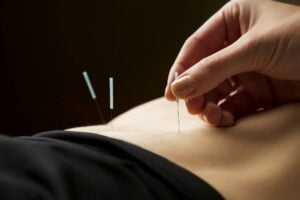As women approach the transitional phase known as perimenopause, they often find themselves contending with a variety of physical and emotional changes. Among the most common and notorious symptoms are hot flashes, which can disrupt daily life and leave many women seeking effective strategies for relief. In this blog, we will delve into the world of perimenopausal hot flashes, exploring the range of perimenopause hot flashes treatment options to help you reclaim control over this aspect of your journey.
Contents
When To Seek Perimenopause Hot Flashes Treatment?
 Knowing when to seek treatment for perimenopausal hot flashes is essential for maintaining your well-being during this transitional phase. The decision to seek treatment depends on the impact these hot flashes have on your daily life and overall quality of life. Here are some indicators that may suggest it’s time to explore treatment options:
Knowing when to seek treatment for perimenopausal hot flashes is essential for maintaining your well-being during this transitional phase. The decision to seek treatment depends on the impact these hot flashes have on your daily life and overall quality of life. Here are some indicators that may suggest it’s time to explore treatment options:
- Frequency and Intensity: If you are experiencing hot flashes frequently throughout the day and night, they are significantly disrupting your daily activities and sleep. Then, it may be time to consider treatment.
- Impact on Sleep: Persistent hot flashes that interfere with your ability to get a good night’s sleep can contribute to fatigue, irritability, and overall decreased well-being. If sleep disturbances become a regular occurrence, seeking treatment is advisable.
- Emotional Impact: If hot flashes are accompanied by mood swings, irritability, anxiety, or feelings of sadness, and these emotional symptoms are affecting your relationships or daily functioning, it may be beneficial to explore treatment options.
- Quality of Life: Consider seeking treatment if hot flashes are significantly affecting your overall quality of life. This includes your ability to work, engage in social activities, and enjoy hobbies and interests.
- Lifestyle Disruption: If you find yourself avoiding certain activities or situations due to the fear of experiencing hot flashes, it may be time to seek treatment. Limiting your lifestyle due to symptoms can hurt your mental and emotional well-being.
- Personal Distress: If hot flashes are causing significant personal distress and frustration, affecting your self-esteem or self-image, it’s a valid reason to explore treatment options.
It’s crucial to recognize that perimenopausal symptoms vary from woman to woman, and the decision to seek treatment is a personal one. If you are unsure whether your symptoms warrant treatment, consulting with a healthcare professional can provide valuable guidance.
What Are Some Perimenopause Hot Flashes Treatment?
Perimenopause hot flashes treatment can vary from person to person, and what works best for one individual may not be as effective for another. The choice of treatment depends on the severity of symptoms, overall health, personal preferences, and medical history. Here are various treatment options for hot flashes during perimenopause:
Hormone Replacement Therapy (HRT)
Hormone Replacement Therapy involves the administration of estrogen, and sometimes progestin, to address the hormonal imbalances that occur during menopause. Estrogen helps alleviate symptoms like hot flashes by stabilizing hormone levels. HRT can be administered through pills, patches, creams, or gels. While highly effective in reducing hot flashes, it’s essential to consider potential risks, such as an increased risk of blood clots, stroke, and breast cancer.
Non-Hormonal Medications
In cases where hormone replacement therapy is not suitable, non-hormonal medications like selective serotonin reuptake inhibitors (SSRIs) and serotonin-norepinephrine reuptake inhibitors (SNRIs) may be considered. Drugs like venlafaxine and paroxetine, originally developed as antidepressants, have been shown to reduce the frequency and intensity of hot flashes. These medications work on the central nervous system and can be a viable option for women who cannot or prefer not to use hormonal treatments.
Gabapentin and Pregabalin
Originally designed to treat seizures and nerve pain, gabapentin and pregabalin have demonstrated efficacy in reducing hot flashes. While the exact mechanism is not fully understood, these medications appear to influence neurotransmitters involved in temperature regulation. They may be recommended for women who do not find relief from other treatments or those who cannot use hormonal therapies.
Clonidine
Clonidine, typically used to manage high blood pressure, is effective in reducing hot flashes. It works by affecting the central nervous system and has a calming effect, which can help mitigate the frequency and intensity of hot flashes. Clonidine is available in both pill and patch form, and its use should be discussed with a healthcare professional to determine the most suitable option.
Lifestyle Modifications
Lifestyle changes play a crucial role in managing hot flashes. Wearing lightweight, breathable clothing can help regulate body temperature, and using fans or cool compresses can provide immediate relief during a hot flash. Maintaining a cool sleep environment and avoiding triggers like spicy foods, caffeine, and alcohol may contribute to symptom reduction. While these modifications may not eliminate hot flashes, they can significantly improve the overall experience of perimenopausal symptoms and enhance daily comfort.
Herbal Remedies
Some women explore herbal remedies as an alternative approach to managing hot flashes. Black cohosh, evening primrose oil, and soy isoflavones are among the commonly used supplements. Black cohosh, in particular, has been studied for its potential to alleviate menopausal symptoms, including hot flashes. However, the effectiveness of herbal remedies varies among individuals, and scientific evidence supporting their efficacy is mixed. It’s crucial to consult with a healthcare professional before trying herbal supplements.
Acupuncture
 Acupuncture, an ancient Chinese practice involving the insertion of thin needles into specific points on the body, has gained attention as a potential method for reducing the frequency and severity of hot flashes. While research on acupuncture’s effectiveness for hot flashes is ongoing, some women report positive outcomes. The precise mechanisms are not fully understood, but it is believed that acupuncture may influence the central nervous system and hormone levels.
Acupuncture, an ancient Chinese practice involving the insertion of thin needles into specific points on the body, has gained attention as a potential method for reducing the frequency and severity of hot flashes. While research on acupuncture’s effectiveness for hot flashes is ongoing, some women report positive outcomes. The precise mechanisms are not fully understood, but it is believed that acupuncture may influence the central nervous system and hormone levels.
Mind-Body Techniques
Techniques that focus on the mind-body connection, such as mindfulness, yoga, and relaxation exercises, can be valuable tools in managing hot flashes. These practices help reduce stress, which, in turn, may alleviate the frequency and intensity of hot flashes. Cognitive-behavioral therapy (CBT) is another approach that can assist in reframing thoughts and managing emotional responses to symptoms. Integrating these techniques into daily life may contribute to an overall sense of well-being during the perimenopausal transition.
Vitamin E
Vitamin E supplements have been investigated for their potential to reduce hot flashes. While some studies suggest a positive effect, the evidence is not conclusive, and results can vary among individuals. Vitamin E is an antioxidant, and it’s hypothesized that it may help regulate estrogen levels. Before incorporating vitamin E supplements into your routine, it’s essential to consult with a healthcare professional to determine the appropriate dosage and ensure it does not interact with other medications.
Regular Exercise
Engaging in regular physical activity has been associated with a reduction in the frequency and severity of hot flashes. Exercise contributes to overall cardiovascular health and may help regulate hormonal fluctuations. Activities such as walking, swimming, or yoga can be beneficial. Exercise also has additional benefits, including improved mood, better sleep, and enhanced overall well-being. It’s important to choose activities that you enjoy and that align with your fitness level. Thus, making it more likely to maintain a consistent exercise routine.
Remember that individual responses to these treatments vary, and what works for one person may not be as effective for another. Regular communication with your healthcare provider allows for ongoing evaluation of the chosen strategies and adjustments as needed to optimize symptom relief.
How Can I Treat Perimenopause Hot Flashes Naturally?
 When it comes to natural treatment of perimenopause hot flashes, below are the best approaches to help:
When it comes to natural treatment of perimenopause hot flashes, below are the best approaches to help:
Hydration
Staying well-hydrated is essential for overall health and can help regulate body temperature. Carry a reusable water bottle and aim to drink plenty of water throughout the day. Adequate hydration can contribute to better heat regulation and may alleviate the intensity of hot flashes.
Cooling Foods
Incorporate cooling foods into your diet, such as cucumbers, watermelon, and mint. These foods may help regulate body temperature and provide a refreshing sensation. Including a variety of fruits and vegetables in your meals supports overall health and may contribute to symptom relief.
Breathing Exercises
Practice slow and deep breathing exercises to help manage stress and reduce the frequency of hot flashes. Deep breathing can activate the body’s relaxation response and contribute to a sense of calm. Try techniques such as diaphragmatic breathing or paced respiration for a few minutes each day.
Flaxseed
Flaxseed contains lignans, which are compounds that may have estrogen-like effects. Some studies suggest that incorporating flaxseed into your diet may help reduce the frequency and intensity of hot flashes. You can add ground flaxseed to yogurt, and smoothies, or sprinkle it on salads.
Aromatherapy
Certain scents, such as lavender and peppermint, may have a calming and cooling effect. Experiment with aromatherapy by using essential oils in a diffuser or diluted in a carrier oil. Inhaling these scents during a hot flash may provide a sense of relief.
Mindful Eating
Pay attention to your diet and how certain foods may trigger or alleviate hot flashes. Spicy foods, caffeine, and alcohol are common triggers for some women, so consider reducing or eliminating these from your diet. Opt for a balanced diet rich in whole foods to support overall health.
Natural Fiber Clothing
 Choose clothing made from natural, breathable fibers like cotton or linen. These materials allow for better air circulation, helping to regulate body temperature and minimize discomfort during hot flashes.
Choose clothing made from natural, breathable fibers like cotton or linen. These materials allow for better air circulation, helping to regulate body temperature and minimize discomfort during hot flashes.
It’s important to approach natural remedies with an awareness that individual responses vary. If you are considering significant dietary changes or introducing supplements, it’s advisable to consult with a healthcare professional to ensure these approaches align with your overall health and medical history.
Conclusion
In conclusion, managing perimenopausal hot flashes involves a personalized approach that considers various factors like lifestyle, preferences, and health history. From lifestyle adjustments to exploring medical options like hormone replacement therapy, women have a range of choices. Natural remedies such as mindfulness, cooling foods, and incorporating flaxseed into the diet offer additional avenues for relief. It’s essential to consult with a healthcare professional to determine the most suitable strategies for individual needs.
Remember, every woman’s journey through perimenopause is unique, and finding the right combination of treatments may take some time. By staying informed, seeking support, and being proactive in your health, you can navigate this phase with greater ease and reclaim a sense of well-being. If you are facing menopause-related issues, menopause treatment at HerMantra can help. Book your free trial online menopause treatment session now.


